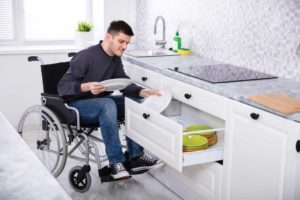Design fundamentals of accessible and adaptable dwelling units
 By Avinash Gupta, P.Eng., CBCO, CRBO, LBO, and Dominic Esposito, P.Eng.
By Avinash Gupta, P.Eng., CBCO, CRBO, LBO, and Dominic Esposito, P.Eng.
An adaptable dwelling unit means an accessible unit that can be tailored at any time to the specific accessibility needs of occupants, as those needs evolve without costly renovations, disruption, and structural changes. For an adaptable unit, it is crucial to design and construct the required building’s permanent elements as accessible.
Common features to install in a fully accessible dwelling unit
- Step-free access or ramped access (both external).
- Paved walkway, with a sufficiently flat slope of 1:20 from parking (within the property) to the unit’s entrance.
- Support rails on approach to a unit (external).
- Larger than normal garage to accommodate loading and unloading.
- Level-access throughout within the building.
- Low-pile carpeting with thin padding.
- Wide entrances, wide doorways, and wide hallways.
- Lever-type handles on door hardware.
- Accessible and easily operable windows.
- Sufficiently empty floor space to accommodate a wheelchair turning radius.
- Increased structural design to support hoists—rough-in blocking allows the grab bars, rails, or ceiling hoists for later installation so the individual can simply screw the bars in place without opening existing walls.
- Wet rooms or walk-in bath, adjustable or handheld lever hand faucets, showerhead, and accessible toilets and bathing seats.
- Lowered countertops segments and the kitchen is designed for wheelchair mobility, with adjustable kitchen cabinets.
- Lowered environmental/electrical controls such as light switches, thermostats, doorbells, mailboxes, etc.
- A stairlift or wheelchair lift between floors.
design
Accessible dwelling unit
On the other hand, an accessible dwelling unit means a unit which meets the needs of people with disabilities. It refers to a space, feature, element, site, environment, or facility that can be located or approached, entered, exited, or operated—used—by people with varying disabilities, with or without mobility aids or assistive devices.
An accessible dwelling unit contains most features that may be essential for converting it into an adaptable dwelling unit without expansive, disruptive structural changes and the intervention of the local approving authority. Therefore, an accessible dwelling unit will require all permanent structural accessible elements in it; these can be wider doors, hallways, and controls. The rough-in features can be adapted to convert an accessible into an adaptable unit anytime, as the number and type of adaptable features may vary significantly for each person.
This article explores various options to increase the number of accessible and adaptable dwelling units in terms of detached single-family dwelling units (SFDUs) and multi-unit residential buildings (MURBs) across Canada.







